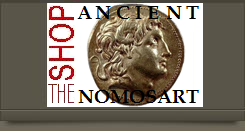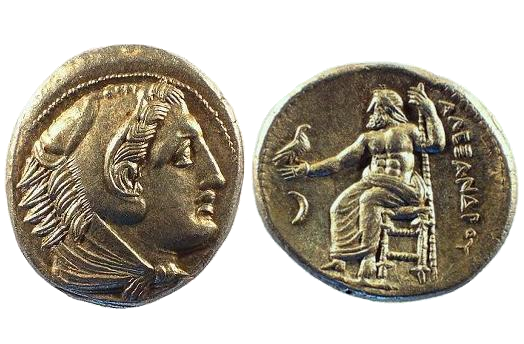
about ancient nomos
Ancient Nomos Art is a museum of galleries exhibiting ancient coins and ancient mint maps. The coin gallery displays the diverse art and history of hand-crafted ancient Greek, Roman, Byzantine, Persian and Medieval coinage. The ancient mints mapping gallery features Greek, Roman, Byzantine, Asia Minor and Medieval mint city regions and territories. Visitor's are welcome to explore, study and enjoy Ancient Nomos Art.

Greek, Amphipolis – 336 BC
Amphipolis
From Ancient Galleries

Obverse: Head of Herakles facing right and wearing lion's skin headdress.
Reverse: Zeus enthroned, holding eagle on right hand and sceptre in left hand.
LEGEND SYMBOLS
Obv: Head of Herakles facing right, wearing a lion’s skin headdress. Rev: ΑΛΕΞΑΝΔΡΟΥ to right, Zeus enthroned holding eagle in out stretched right hand and scepter in left hand; crescent in field.
This lifetime issue of Alexander the Great silver tetradrachm, struck under Antipater, depicts the head of Herakles on the obverse facing right and wearing the lion’s skin headdress. The coin reverse depicts the ancient Greek god Zeus, who reigned superior among the gods and is the father of Herakles. Zeus is seen sitting on his throne holding a scepter in his left arm and eagle on his out stretched right hand. Some in the past have suggested the image of Herakles might be Alexander himself, but the differing faces of Herakles throughout the regions of Greece and his full length, elderly beard offers little convincing evidence. However, the Odessa mint die evidence and legends of Mithradates VI used this rulers image as Herakles on tetradrachms. Alexander selected the Herakles because he was considered the greatest hero god and is known to have attained divine status by accomplishing the twelve great tasks known as the Twelve Labors of Herakles. The association of a great leader and philosopher-king mortal such as Alexander aligned with the status of a god may have been an attractive image for Alexander. The obverse lion skin headdress that appears on Herakles is the lion skin of the Nemean lion, killed by Herakles during his first of twelve labors. There were two main styles on the coins reverse. The first depicts Zeus with his legs side by side and second style depicts his right leg behind the left. Most of Alexander’s lifetime issues depict Zeus with his legs side by side. There are generally two types of inscriptions found on the reverse of Alexander coins. The primary inscription is ΑΛΕΞΑΝΔΡΟΥ (Alexander) and ΒΑΣΙΛΕΩΣ ΑΛΕΞΑΝΔΡΟΥ (Alexander the King). After Alexander’s death, post-humus coin legends varied from region to region depending on the Greek ruler. Generally, the title “King” was not on Alexander’s lifetime coins because the idea of being ruled, at this time, was contrary to Greek citizens.
DOCUMENTATION
Value: Tetradrachm. Metal: AR Silver. Weight: 17.22 grams. Mint: Amphipolis. Date: 325 – 323 BC.
Attribution: Price 89; Müller 259; SNG Cop 674; Troxell, Studies, Issue E7.
Legend, Documentation and Attribution
